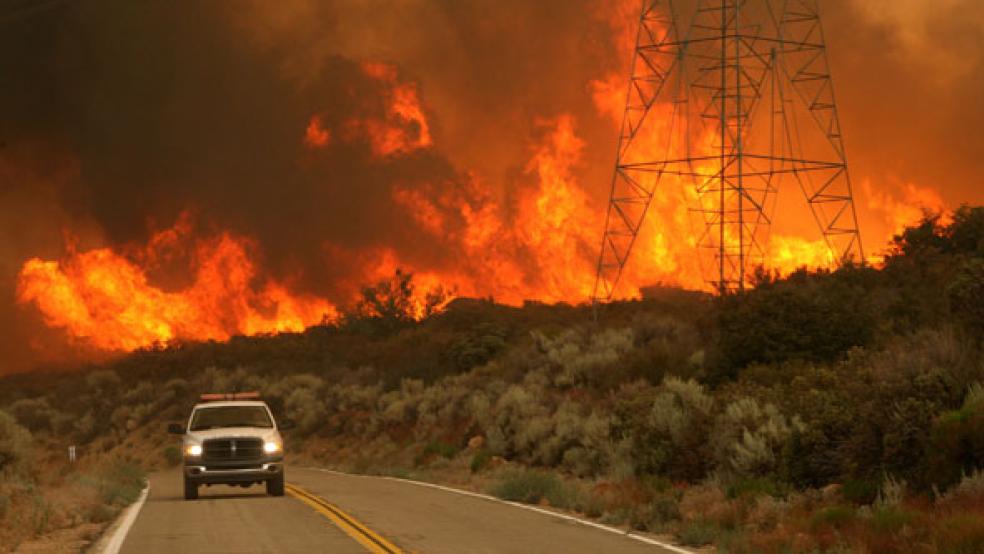As states across the country grapple with 2012 budget shortfalls, extreme weather is making for an increasingly expensive and complicated recovery.
To be sure, states ravaged by natural disasters are rarely left holding the entire bill. But federal assistance is neither guaranteed nor substantial enough to pay for a full recovery, leaving the majority of cash-strapped states on the hook to help finance the cleanup.
When President Obama declares a major disaster, a category designated for the most devastating weather events, the federal government pays a minimum of 75 percent of eligible costs. The state whacked by tornadoes or hurricanes or wildfires picks up the tab for the remaining 25 percent. Additionally, the Federal Emergency Management Agency offers little help to important state industries that have lost revenue from a disaster event.
Just last week, 362 tornadoes ripped through Alabama , Oklahoma, Mississippi, Tennessee, Georgia, Virginia, and Louisiana, the deadliest outbreak since 1936. Communities were decimated,, and at least 350 people died. In hard-hit Tuscaloosa, Alabama, officials estimated that debris removal alone will cost $70 million to $100 million, further exacerbating the state’s 2012 budget shortfall of nearly $1 billion. All seven states, in fact, project 2012 budget gaps--Georgia ($1.3 billion), Louisiana ($1.6 billion), Mississippi ($634 million), Oklahoma ($500 million), Tennessee (unknown), and Virginia ($2 billion), according to the Center on Budget and Policy Priorities.
“Obviously we got a lot of folks out of work, major employers in affected communities with no facilities to operate from, and we’ve got thousands of people without homes,” says Alabama Finance Director David Perry. “We're worried about significant losses of sales and income taxes, [though] the rebuilding effort will help offset some of that, but not all of it. The other major concern is finding the state money to match expenditures out here. FEMA is going to be spending probably hundreds of millions of dollars in the cleanup, yet the state share has a potential to be a significant budget-buster. And we don’t have a lot of room in the budget right now.”
In 2010, 49 of the 50 states requested some sort of federal assistance for extreme weather. So far in 2011, President Obama has granted major disaster assistance to 20 states for catastrophes ranging from severe flooding in the Midwest to tsunami waves in California and Hawaii to severe snowstorms in Connecticut and New York. But because the money is not released as a block grant, states often end up in a bureaucratic battle over what damages are eligible for coverage.
“FEMA is trying to be a careful steward of the tax money, and they’re really looking to make sure the scope of the work isn’t beyond the damage,” the former FEMA official says. “So you have a lot of engineers arguing with each other and local and state people who feel squeezed for money.”
In Texas, the wildfires sweeping from the eastern border near the Sabine River out to the western mountains and on up to the panhandle have claimed about 2 million acres--killing livestock, destroying farming infrastructure, and ruining grazing land. Texas is the largest producer of cattle in the U.S., and agriculture represents 10 percent of the state’s overall economy. Any disruption in cattle farming will only add to the already increasing cost of beef.
With the state already facing a projected $13.4 billion budget shortfall, according to the Center on Budget and Policy Priorities, and now saddled with an estimated $70 million for damages incurred during the wildfire season, Governor Rick Perry has formally requested federal assistance from Obama. (Governors can declare state emergencies, but they then must petition the Administration to declare a federal state of emergency.)
“It’s not unusual to have a winter fire season, but it is unusual to have the fuels this dry across the state,” said Mark Stanford, fire operations chief for the Texas Forest Service. “This could get significantly worse. The fuels are particularly volatile right now and abundant, and that’s not going to change.”
Texas farmers alone normally produce about 100 million bushels of wheat a season, which is selling at about $8 a bushel. But this year, farmers are expected to produce about a third of that, says economist Mark Welch of Texas AgriLife, an education service partnered with Texas A&M University. That adds up to roughly half a billion dollars in lost revenue-.
Cattle farmers, meanwhile, have lost thousands of acres of pasture land. “If you’re going to keep your livestock, you’ve got to go and buy feed to replace what they’re not going to get on the pasture and then you’ve got to buy that ranch infrastructure,” said Dr. David Anderson, a livestock economist. “That’s a huge number.”
Related Links:
US tornado outbreak was “biggest ever’ (BBC)
Southern storms death toll nears 300 (CNN)
The Long War Against Deadly Tornadoes (NPR)




